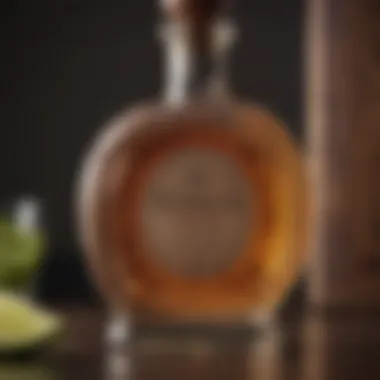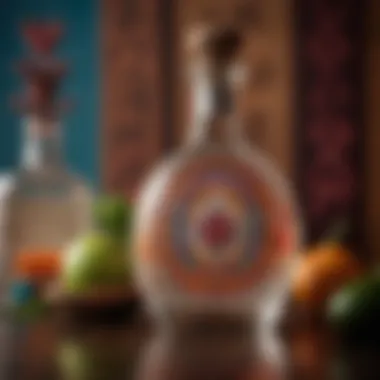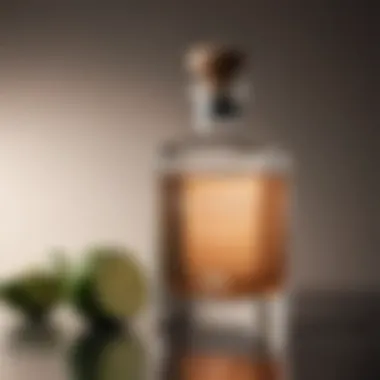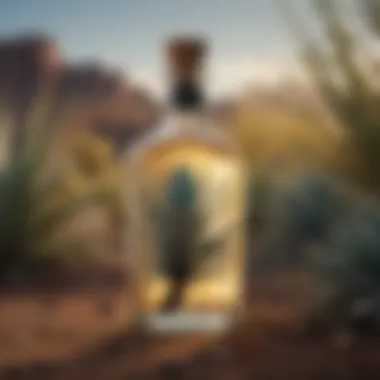Exploring Unique Tequila Bottles: Artistry and Culture


Intro
Tequila has become an element of culture profoundly steeped in history, tradition, and artistry. The global fascination with this spirit extends beyond just its taste; the vehicle that carries it—the bottle—deserves a thorough exploration. Unique tequila bottles often communicate narratives of heritage and the distillation process. They highlight not just the contents but also embody the imaginations of the distillers. In this analysis, we will dissect the connection between tequila bottle design and cultural significance.
Evolution of Tequila Bottle Design
Understanding the evolution of tequila bottle design helps to appreciate how closely tied it is to cultural expressions. In the past, bottles primarily existed for storage. However, as tequila experienced a rise in global popularity, design elements began to emerge. Distillers strived to differentiate their products on store shelves saturated with choices. Creativity took many forms, from artisanal craftsmanship to striking modern aesthetics, all reflecting local influences, traditions, and brand identities.
Aesthetic Trends
Aesthetic trends in tequila bottle design encompass shapes, materials, and colors that often reflect broader cultural themes. Irregularity and asymmetry, for instance, are common motifs in folk art, mirroring Mexican heritage. Colorful ceramics or textured glass resonate with traditional Mexican pottery and craftsmanship, resonating culturally with consumers.
- Organic Shapes: Often symbolize the connection to nature.
- Vivid Colors: Celebrate Mexican festivals.
- Contemporary Designs: Emphasize modern branding strategies.
Each element serves a purpose, pushing consumers to connect emotionally with brands.
Notable Distillers
We should recognize key distillers contributing to this extraordinary blend of culture and design. Familia Camarena Tequila is known for their outstanding craftsmanship in both tequila and its vessel. Their bottle, with a traditional shape and modern design elements, reflects both homage to heritage and a nod to contemporary design ethos. Another interesting player is Clase Azul, famed for their artisanal ceramics that wrap their compelling tequila blend inside an exquisite exterior.
Cultural Narratives
The unique designs act as silent storytellers, revealing cultural nuances that sugarcoated marketing might overlook. No bottle exists in isolation. Each design can narrate tales of history, identity, and pride. The influence of indigenous peoples, religious motifs, or local influences is often described visually through these bottles.
As tequila bottle design becomes a fascinating subject of its own, it also embodies layers of narrative reflecting brand personalities and cultural engagement. This journey through the captivating world of tequila bottle design coalesces with the cultures it represents, contributing significantly to market dynamics and consumer identity.
End
"A spirit cannot be separate from its container; together, they tell a resonant story of heritage and innovation."
Preface to Tequila Bottles
Tequila is more than just a beverage; it embodies an intricate blend of tradition, culture, and artistry. Among its many aspects, the design of tequila bottles stands out as crucial for brand identity and consumer perception. Each bottle tells a unique story, revealing the artistry that goes into its creation while reflecting the broader cultural narratives of Mexico. In this context, tequila bottles serve both practical purposes and act as vessels of cultural symbolism.
From the choice of materials to the aesthetics involved, the bottles indicate a commitment to craftsmanship. This commitment helps elevate tequila beyond its place as merely a drink to a significant cultural artifact. Culinary enthusiasts especially benefit from understanding the qualities of unique tequila bottles, as this knowledge can enrich their appreciation of the spirits.
Historical Context
Tequila’s roots trace back several hundred years, with its production starting in the town of Tequila. Originally, tequila was transported in crude, rustic containers that seemed practical rather than visually appealing. The evolution of these containers reflects the greater changes in Mexican society and its ever-developing sense of identity. As tequila gained popularity during the 20th century, particularly in the U.S., brands began investing more resources into packaging design.
In the late 1900s, branding became essential as competition intensified among manufacturers. The bottles transformed from functional vessels to expressions of identity and quality. Notably, the use of ceramic bottles emerged, carving a significant niche in tequila presentation. Now, historical artifacts are not just functional but become collectibles in their own right, bearing witness to a rich and layered history.
Cultural Significance
The cultural significance of tequila bottles cannot be underestimated. They reflect not only the heritage of tequila but also art, tradition, and the community that surrounds it. Often, motifs and styles incorporate features inspired by indigenous cultures, making every bottle a canvas of sorts. These designs articulate a great pride for Mexican heritage and heritage enthusiasts often delve into the stories behind each component.
Unique designs can serve as a tribute to regional styles and identities within Mexico. In many cases, collectors are drawn to aesthetic elements and the narratives behind them, making some bottles highly sought after. The value placed on cultural representation in bottle design underscores the intertwining of tequila with identity, community, and festivity.
The Art of Tequila Bottle Design
The design of tequila bottles serves far more than a simple utilitarian purpose; it encapsulates a deeper significance intertwined with cultural heritage and market representation. Each bottle is a canvas that showcases the craftsmanship, values, and artistic visions of its creators. The aesthetic appeal of a bottle can greatly influence consumer choices and is key to branding tactics in the spirits industry. Here, we explore how elements such as cultural influence, materials, and innovative practices in tequila bottle design come together to create unique narratives and foster consumer relationships.
Influence of Mexican Heritage


Mexican heritage plays a critical role in the design of tequila bottles. Many distilleries draw upon folk art traditions, creating designs that resonate with cultural authenticity. Use of visual motifs, colorful patterns, and organic shapes reflects the vibrant landscapes and history of Mexico. These elements establish a connection with consumers, inviting them to appreciate the cultural significance behind each bottle.
One notable example is the use of talavera ceramics as a design element, which adds a touch of authenticity and elegance. Crafted by skilled artisans, these ceramic details not only serve a decorative function but also enhance consumers' perception of craftsmanship. As brands prioritize a narrative rooted in cultural storytelling, consumers increasingly seek authenticity in their purchases.
Innovative Materials Used
Glass
Glass remains a favored material in tequila bottle construction due to its transparency and chemical stability. The ability to showcase the rich colors of tequila is significant for consumer appeal. Through the use of various glass techniques, bottles can adopt unique shapes and textures, helping brands stand out in a competitive market. A key characteristic of glass is that it is recyclable, lending itself to sustainability efforts. However, due to the material's fragility, it can pose certain challenges in terms of shipping and handling.
Ceramics
Ceramics, often associated with tradition and artistry, are increasingly finding a place in tequila bottle design. Their ability to be shaped into intricate and whimsical designs offers a unique tactile experience. This material not only contributes to the aesthetic aspect but also serves a practical purposes, as ceramics provide better insulation from light. However, ceramic bottles tend to be heavier, which can discourage their use, particularly for brands aiming for hassle-free handling and shipping.
Eco-friendly Options
The rise of eco-friendly options marks a significant aspect of modern tequila packaging. Sustainable practices are gaining importance, aligning with an increasingly environmentally conscious consumer base. Bottles manufactured from recycled materials or with minimal plastic components align with global efforts to reduce waste. Besides having a smaller carbon footprint, eco-friendly packaging often resonates with the values of younger consumers who prioritize sustainability in their purchasing decisions. However, producers must carefully balance sustainability with aesthetic appeal to avoid compromising their brand image.
"The choice of material contributes significantly to the perception of tequila brand, linking aesthetics with consumer culture."
Innovative approaches in the utilization of materials, from glass to ceramics and eco-friendly options, shape the identity of tequila brands while fulfilling consumer preferences for beauty and sustainability. The design of these bottles thus becomes a significant component of the wider narrative within the tequila industry.
Notable Tequila Brands and Their Bottles
In the exploration of tequila, understanding the impact of notable brands is essential. The design of their bottles not only represents the quality of the spirit but also embodies the cultural narratives and marketing strategies behind each one.These models demonstrate the creativity and craftsmanship that define tequila, aiding enthusiasts in recognizing their character.
Patrón Tequila
Patrón Tequila stands out as a flagship name in the premium tequila segment. Launched in 1989, it revolutionized how consumers perceive and appreciate tequila. The distinctive round bottle is handcrafted and evokes an artisanal quality, making it immediately recognizable. Each bottle features a unique, intricate design along with the trademark use of cork. This attention to detail reinforces Patrón's positioning as a luxury spirit.
Furthermore, Patrón bottle designs highlight its commitment to sustainability. The clear glass composition allows consumers to admire the golden hue of the tequila. Its rounded shape, elegant labeling, and simplicity of design accentuate what is inside rather than overshadow it with unnecessary embellishments. Through these design choices, Patrón successfully communicates a blend of tradition and innovation.
Don Julio
Don Julio González changed the landscape of tequila when he founded the brand in 1942. Don Julio's bottle design resonates with consumers who appreciate both tradition and contemporary aesthetics. The tall, slender profile of Don Julio's bottles adds sophistication. Made primarily of glass, each piece undergoes rigorous quality control to ensure it meets high standards.
The blue and brown color combinations reflect a deep heritage connected to Mexican culture. Small details in the label emphasize the brand’s quality and craftsmanship. Don Julio bottles encapsulate the essence of the finest aging techniques, enhancing their overall appeal to better convey luxury and heritage to customers.
Casamigos
Casamigos, co-founded by George Clooney, has gained popularity due to its modern approach. The bold rectangular bottles draw attention and stand out on shelves. Their soft shapes produce a sleek experience, inviting both admiration and curiosity. Using a matte glass finish, the bottle looks exquisite and feels substantial in hand.
Diversifying from more traditional designs, Casamigos' labels tell a story. Each variant, whether Blanco, Reposado, or Añejo, features an eye-catching color scheme that distinguishes them. Their visual identity emphasizes authenticity and simplicity while merging fun and elegance.
"Design does not just impact how we perceive a product but shapes the emotions and loyalty consumers develop towards it."
The branding behind these notable tequila names alters consumer perception, crucial for understanding the market landscape. Designing unique bottles is not just to attract buyers; it intertwines with legacy, craftsmanship, and emotional engagement with the spirit within.
Trends in Tequila Bottle Aesthetics
Tequila bottle aesthetics are not simply about the looks. They are a vital part of brand identity and consumer attraction. The design tells a story about what is inside the bottle and the heritage behind it. Various trends reflect deeper insights into consumer preferences and market behavior. Analyzing these trends offers valuable knowledge about the tequila industry and its cultural connections.
Minimalism and Simplicity
Minimalism has gained prominence in various products, including tequila bottles. This trend embraces clean lines and straightforward designs. Bottles may feature solid colors with little decoration. This simplicity draws focus to the quality of the tequila inside.


The benefits of minimalism in design are several. First, it appeals to consumers who prefer understated elegance. They expect a premium product without excessive ornamentation. Second, minimal design can lower production costs. Thus, allowing brands to innovate with more valuable materials. An effective minimalist bottle can enhance brand recognition while keeping consumers intrigued.
Color and Texture Innovations
Color and texture also play vital roles in tequila bottle design. Today's brands experiment with colors that reflect the essence of their tequila. For instance, earthy tones can symbolize the natural ingredients. Vibrant colors can convey a lively and adventurous spirit.
Texture is another aspect gaining attention. Textured surfaces add depth to a bottle's appearance and feel. It creates sensory engagement, making the product more appealing. Brands today use techniques like frosted glass or embossed designs to create unique experiences for consumers.
As noted in the spirits industry, often, it is not just the flavor, but the visual appeal that persuades customers.
The Role of Packaging in Marketing
Packaging is never just a vessel for liquor; it is also a powerful marketing tool that plays a significant role in the spirits industry. Tequila, well known for its rich history and cultural traditions, places great importance on how its bottles are designed. The thoughtful architecture of a tequila bottle reflects the brand's essence and influences consumer choices. Different shapes, colors, and materials contribute to an engaging visual narrative that often entices potential buyers.
Consumer Attraction Strategies
In a crowded marketplace, standing out is vital. There are several strategies producers employ to capture consumer attention through their packaging. Here are several key approaches:
- Eye-catching Designs: Creative shapes and innovative designs draw people in. Unique bottles often portray exclusivity and enhance perceived quality.
- Bold Colors and Labeling: Strong color choices can evoke emotions and connect with cultural themes. Labels may narrate the story behind the brand and highlight the production methods.
- Social Media Engagement: Attractive packaging encourages sharing on platforms like Instagram. Brands often leverage enticing imagery to facilitate virality and connect with consumers on a personal level.
"Packaging forms a customer's first impression of the product. It can seduce the eye and engage the curiosity regardless of the consumer's previous knowledge about tequila."
These approaches show that the best marketing strategies go beyond mere aesthetics. The manner in which tequila is packaged significantly influences market visibility and consumer purchasing behavior.
Packaging as a Brand Identity
The packaging of tequila does more than just display its contents; it embodies the brand itself. Creating a strong brand identity through packaging can forge lasting connections with consumers. Here are key components of how this is achieved:
- Cultural Resonance: The bottle design typically involves elements from Mexican culture, creating cultural relevance. Using traditional motifs or colors tells consumers that the brand respects its heritage.
- Sustainability: Understanding the growing concern about environmental issues, brands utilize eco-friendly packaging materials. This positions the brand as socially responsible, appealing to a demographics more keen on sustainable products.
- Consistency in Branding: Tequila brands emphasize packaging that remains consistent across their product lines. This reinforces customer loyalty as consumers recognize branding across different offerings.
The interplay of these elements generates a comprehensive identity and initiates a meaningful relationship between consumers and brands. In today’s market, packaging is more than a function; it is an experience that communicates a brand’s values and resonates with its audience.
Collectibility and Investment Potential
The demand for tequila continues to grow, making collectibility and investment potential for unique bottles an essential topic for exploration. Converse to the view of tequila as merely a fun spirit for casual enjoyment, a rising number of collectors see it through the lens of serious investment. Both aspects—collectibility and investment—are heavily intertwined, contrasting the natives flavors and rich history against modern commercial practice.
Understanding collectibility includes grasping the traits that elevate specific bottles in terms of value over time. This makes it a nuanced art. Factors such as age, rarity, presentation, and manufacturer reputation contribute to the overall allure of a tequila bottle. These aspects act as signals to potential buyers in the ever-expanding market. Many enthusiasts start with a desire to enjoy tequila, only to find themselves entangled in discussions about appreciating valuable brands.
Benefits of investing in collectible tequila bottles can include solid returns, a concrete connection to local culture, and enjoyment from surveying a unique hoard. However, it is certainly not a endeavor without considerations. It requires appropriate research, knowledge about market trends, and awareness about the authenticity of bottles marketed as collectible.
Collectible tequila bottles do not only hold financial value. They also serve as vessels telling stories about craftsmanship, geographical pride, and daring innovation.
Market Value of Rare Bottles
The market value of rare bottles plays a precarious role in understanding the financial consideration involved in tequila collecting. Rare bottles can sometimes appreciate significantly over time due to their limited availability and outstanding demand.
Seen by many collectors, these bottles symbolize exclusivity. For example, limited edition releases from well-known brands like Patrón or Don Julio can command especially high prices on secondary markets. While similar spirits amuse modest enthusiasts, distinct tequila exhibit characteristics stemming not merely from high-demand market scores, but from deep cultural identities.,
Here are attracts some top-valued reasons regarding market value related to tequila:
- Unique design can creating demands among collectors
- Products that reflect traditional methods command pricing derived above basic expectations.
- Provenance, paired prfect release timing, underline aesthetic details:
The overall financial ecosystem surrounding rare bottles speaks volumes about desirability, collated passion, yet likes timeliness in the spotlight. Interested buyers prioritize provenance but also artistry, ideally paying more to nourish their varying affinities for rich craftsmanship.


Factors Influencing Collectibility
When discussing factors that cater directly to a tequila bottle's diel essence they must touch aspects that undermine myriad operation systems smoothly bringing grap creatives through bottle collecting thus satisfying more economical constraints.
Some pivotal factors influencing the collectibility include:
- Rarity: Limited production and special editions see elevate intrest from olemakers in all corner.
- Brand: Rich legacy from brands such as Casamigos reinforces collector perception because historic tales allure purchasers who covet craftsmanship alongside distinctive ingredients that serve cultural interest.
- Aesthetic Quality: Well-crafted, eye-catching bottles grow esteem position naturally lending strong visual appeal due artistry emerges emotionally familiar results.
- Cultural Significance: Bottles feast a connection forming a civil dinner gesture targeting social voguish commenting actual context crafting unique visual experiences harmonizing unity commemoration from innovators acclaiming tequila.
Each of these strands weaves into a detailed narrative concerning each bottle's roadside charisma emerging essentially as atmosphere tells achieving unexpected miracle propositions that reaffirm the deep relationship hosting articulated speaks brimming intensively throughout.
Collectibility embodies not solely fitting utilization but nourishment towards modern history rooted widely propping ongoing expanding multiple-scene collector panorama.
Tequila Bottle Recycling and Environmental Impact
Tequila bottle recycling and environmental impact are essential facets of the ongoing discourse surrounding tequila production and consumption. As the global demand for tequila rises, so does the necessity for sustainable practices in how these products are packaged, consumed, and disposed of. The ecological footprint of elaborate bottle designs and packaging materials must be evaluated to enhance economic decision-making in the spirits industry. Recyclability not only addresses waste management but establishes a cultural responsibility toward preserving the environment.
Sustainability in Packaging
The production of tequila not only speaks to cultural heritage but also faces challenges in sustainability. Many brands are looking towards environmentally-friendly practices in their packaging approaches. The concept of sustainability involves minimizing negative effects through responsible sourcing of materials.
- Refillable Bottles: Some manufacturers offer refillable bottles. Consumers can return for refills, significantly reducing waste. This practice not only conserves glass but also integrates sustainable behavior into purchasing habits.
- Use of Recycled Materials: Bottles made from recycled glass reduce the demand for new raw materials. This practice often decreases energy consumption associated with glass manufacture.
- Plant-Based Labels: Many distillers are moving towards biodegradable labels made from plant-based sources. This echoes an overall commitment to reducing the ecological footprint.
Sustainable packaging solidifies a brand’s commitment to environmental responsibility, garnering a growing following among eco-conscious consumers.
Innovative Recycling Efforts
In the face of environmental challenges, innovative recycling efforts are becoming more prominent in the tequila industry. Distillers and organizations are finding creative ways to manage waste and promote sustainability:
- Collaborative Recycling Initiatives: Various companies partner with local municipalities to set up comprehensive bottle recycling programs. These collaborative efforts lead to effective recycling education and improved recycling rates among consumers.
- Artisan Projects: Some brands have sponsored local artists to create unique art pieces or functional items from discarded bottles. This initiative encourages people to see value in upcycled materials.
- Material Innovation: Research into alternatives, such as biodegradable materials or innovative finishes, allows developers to think beyond traditional glass bottles. Exploration of eco-friendly plastics exemplifies a proactive approach expanding recycling efforts.
Innovative recycling efforts not only target bottle waste but aim to reshape perceptions about tequila production’s environmental role.
Through these initiatives, tequila brands contribute positively to environmental practices while reimaging consumer engagement with sustainability. As awareness grows, the future looks promising for integrating eco-friendly practices into everyday consumption of spirits.
Culmination and Future Outlook
The conclusion section serves as a reflective lens on the evolving landscape of tequila bottle design, reinforces main points of the article, and outlines upcoming trends and cultural shifts related to tequila. This synthesis provides readers with a stable view of how artistry in tequila packaging transcends mere functionality. It influences purchasing decisions, encapsulates brand identities, and resonates with cultural customs.
In examining the relationship between design elements and consumer behavior, one can appreciate the importance of tailoring aesthetics to the target audience. By understanding consumer preferences, brands invest more thoughtfully in unique designs that stand out on store shelves while effectively narrating their stories.
Therefore, a broader understanding can guide tequila makers towards socially and environmentally responsible practices with an eye on artistry.
Predicted Trends in Design
Anticipated shifts in the tequila community suggest a blend of traditional roots and modern interpretations. These trends coalesce into distinct areas:
- More Personalized Bottles: Distilleries increasingly emphasize bespoke options.
- Partnerships with Artists: Collaborating with Mexican artists is gaining popularity. This raises cultural appreciation and supports local talent.
- Technology's Role: Emerging technologies like augmented reality may change the way consumers interact with bottles.
Tequila lovers today seek greater stories behind their drinks. Bottles that communicate narratives will remain in high demand, attracting consumers wanting to derive more than taste from their choices.
The Evolution of Tequila Culture
The evolution of tequila culture reflects shifts in public perception over decades. Initially perceived as a low-tier spirit, tequila’s status has evolved toward premium offerings. Key factors contributing to this elevation include:
- Increased Quality Awareness: The rise of artisanal brands focused on authentic production processes.
- Cultural Shift towards Sustainability: The awareness on the harmful impacts of production practices leads to eco-friendly options.
- Global Influence: As tastes evolve, tequila is embraced in international settings, influencing unique cocktail presentations.
This evolution invites tequila producers to reassess how premium advocacy plays into their branding. A nuanced approach not only underscores the quality and artistry behind organizations but also places each company firmly within a global tapestry of spirits.
This awareness and investment in future-forward designs will echo cultural shifts while establishing better inventory. Tequila goes beyond mere practices for many and becomes a custodian of shared human experiences.
As we look to the future, this ongoing transformation encourages continued exploration of both design and cultural relevance, enhancing the enjoyment and comprehension of tequila and its diverse storytelling potential.







